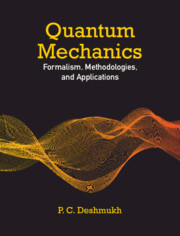Book contents
- Frontmatter
- Dedication
- Contents
- List of Figures
- Foreword
- Preface
- 1 Description of a Physical System
- 2 Path Integral Formulation of Quantum Mechanics
- 3 Probability Tangles and Eigenstates of One-dimensional Potentials
- 4 Angular Momentum
- 5 The Non-relativistic Hydrogen Atom
- 6 Approximation Methods
- 7 The Relativistic Hydrogen Atom
- 8 Quantum Mechanics of Spectral Transitions
- 9 The Many-Electron Atom
- 10 Quantum Collisions
- 11 Introduction to Quantum Information and Quantum Computing
- Appendix A Symmetry of the Hamiltonian
- Appendix B Schrödinger, Heisenberg, and Dirac “Pictures” of Quantum Dynamics
- Appendix C Spherical Harmonics
- Appendix D Occupation Number Formalism Second Quantization
- Appendix E Electron Structure Studies with Qubits
- Index
5 - The Non-relativistic Hydrogen Atom
Published online by Cambridge University Press: 14 September 2023
- Frontmatter
- Dedication
- Contents
- List of Figures
- Foreword
- Preface
- 1 Description of a Physical System
- 2 Path Integral Formulation of Quantum Mechanics
- 3 Probability Tangles and Eigenstates of One-dimensional Potentials
- 4 Angular Momentum
- 5 The Non-relativistic Hydrogen Atom
- 6 Approximation Methods
- 7 The Relativistic Hydrogen Atom
- 8 Quantum Mechanics of Spectral Transitions
- 9 The Many-Electron Atom
- 10 Quantum Collisions
- 11 Introduction to Quantum Information and Quantum Computing
- Appendix A Symmetry of the Hamiltonian
- Appendix B Schrödinger, Heisenberg, and Dirac “Pictures” of Quantum Dynamics
- Appendix C Spherical Harmonics
- Appendix D Occupation Number Formalism Second Quantization
- Appendix E Electron Structure Studies with Qubits
- Index
Summary
One must always do what one really cannot.
—Niels BohrA groundbreaking event in the development of the quantum theory of atomic structure is the remarkable discovery by Johann Jacob Balmer in 1884. He figured out that Anders Jonas Angstrom's measurements of the wavelengths = 4101.2, 4340.1, 4860.74, and 6562.10 Å of the four prominent lines in the spectrum of the hydrogen atom fit the formula, where b = 3645.6 Å, and n = 3, 4, 5, 6. This is an outstanding illustration of the arithmetic genius that Balmer was, being an arithmetic teacher in a girls’ school. Balmer's formula was independently rediscovered by Johannes Robert Rydberg six years later, and rationalized in the planetary model of the old quantum theory proposed by Niels Bohr in 1913. Orbits, however, are intangible, position and momentum measurements not being compatible. Solution to the Schrödinger equation with appropriate boundary conditions satisfactorily account for the Balmer–Rydberg–Bohr formula, explaining the discrete eigenenergies of the hydrogen atom. In Section 5.1, we discuss the bound-state solutions of the Schrödinger equation for the hydrogen atom. However, the Schrödinger equation does not fully account for the degeneracy of the energy levels of (even the nonrelativistic) hydrogen atom. This bemusing condition is addressed in the Sections 5.2 and 5.3 of this chapter, and the continuum eigenfunctions are discussed in Section 5.4.
5.1 Eigenvalues and Eigenfunctions of the Hydrogen Atom
As the very first atom in the periodic table, the hydrogen atom is the simplest one. It is the prototype of one-electron central field atomic systems (including ions) for which exact analytical solution to the Schrödinger equation can be obtained. The electron–proton two-particles Schrödinger equation for the hydrogen atom is
where and are respectively the notional position vectors in a laboratory frame of reference of the electron and the proton, and me and mp their respective masses. The gradient operators and seek space derivatives with respect to the electron and the proton coordinates respectively, and the interaction potential energy operator depends on the relative distance between the two particles. The center of mass of the two particles is located at
and the reduced mass
which is located at the position vector with respect to the center of mass.
Information
- Type
- Chapter
- Information
- Quantum MechanicsFormalism, Methodologies, and Applications, pp. 196 - 269Publisher: Cambridge University PressPrint publication year: 2024
